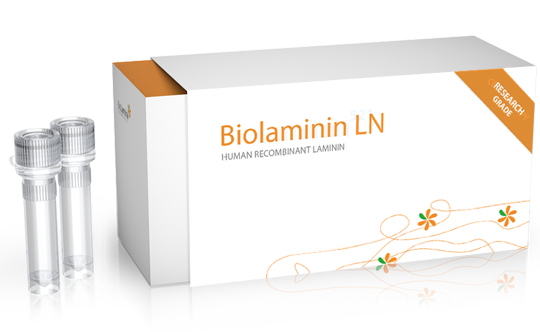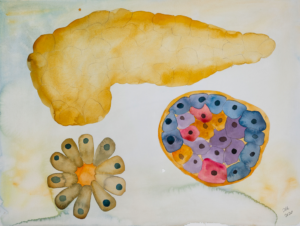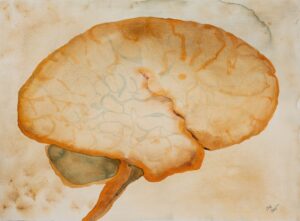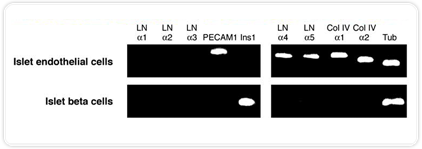Biolaminin 411 LN (LN411)
Human recombinant laminin 411
Biolaminin 411 supports many diverse tissue cell types such as cells from the pancreas and the vascular, immune, nervous, and hematopoietic systems.

A biologically relevant culture environment
One of the main isoforms of laminins in capillaries and larger vessels produced by endothelial cells is laminin 411 and, thus, it has a pivotal role in endothelial basal laminae function (Kortesmaa, 2000; Qian, 2007; Wondimu, 2004). Transgenic mice with an α4-chain laminin deficiency exhibit severe disorganization of microvessels, leading to microcirculation abnormalities (Thyboll, 2002; Wang, 2006).
In addition, during sprouting angiogenesis laminins are produced and deposited from the stalk cells to the tip cell filopodia, and control the diameter size of the vessel lumen (Jakobsson, 2008), further supporting the importance of the protein in endothelial structure and function.
Lymphoid cells are derived from bone marrow stem cells and differentiate either in the thymus or in the bone marrow. Lymphocytes are fundamental for innate and adaptive immunity and patrol the body for foreign antigens that activate them. Laminin 411 is secreted by lymphocytes and supports their proliferation, adhesion, and migration (Geberhiwot, 2001). Laminin 411 is also involved in the survival, adhesion, and migration of blood neutrophils (Wondimu, 2004), and works as an adhesive substratum for bone marrow stem and progenitor cells and promotes progenitor cell migration in vitro (Gu, 2003).
In the embryo, differentiation and insulin expression by the pancreas β cells is initiated by and dependent on specific signals from capillary endothelial cells (Lammert, 2001). However, pancreatic cells are unable to produce the extracellular proteins laminin 411 and laminin 511, which are expressed and secreted by endothelial cells. Instead, the pancreatic islets express vascular endothelial growth factor to attract endothelial cells, providing both oxygen and nutrients and forming the essential vascular network for insulin production by the β cells (Lammert, 2003; Nikolova, 2006).
Data presented by Nikolova (2006) and colleagues suggest that treating islets with these laminins prior to transplantation will help maintain insulin production until new capillaries are formed in transplanted islets and that laminin 411 and laminin 511 in cell culture potentially could mimic the biological environment in the pancreas.
Recommended applications

Pancreatic cells
Biorelevant culture of pancreatic cells on Biolaminin substrates The basement membrane formed next to the beta-cells contains alpha-4 and alpha-5 laminin […]View application
Endothelial cells
Biorelevant culture of endothelial cells Biolaminin isoforms for vascular endothelial cell culture Endothelial cells that make up the vascular network […]View application
Neural cells
Biorelevant culture of neural cells on Biolaminin substrates Laminins are widely expressed in the nervous system and are essential for […]View application
Mesenchymal stem cells
Biorelevant culture of human mesenchymal stem cells on Biolaminin substrates Laminin 521 is widely expressed in the bone marrow and is an […]View application
Key features
Laminins in the pancreas

Islet endothelial cells in mouse pancreas express both laminin 411 (left) and laminin 511 (right) seen as red in these confocal microscopy images. The laminins induce a cell-signaling cascade in the β islet cells, which leads to insulin expression and cell proliferation.
Laminins by endothelial cells

Laminins and other extracellular proteins, including collagen IV, are only produced by islet endothelial cells and not by islet β cells. Laminin 411 and laminin 511 proteins act in concert with instructive and cell-type-specific signals and are also required in liver morphogenesis and growth.
Laminins and insulin

Laminin 411 and laminin 511 in cell culture can partially substitute the biological environment of the pancreas and can therefore help maintain β cell insulin production during islet transplantations before the islets are revascularized by the body.
Coating plates
1. Slowly thaw recombinant laminins at +4°C before use.
2. Dilute the thawed laminin stock solution with 1xDPBS containing Ca2+ and Mg2+.
3. Add the diluted laminin solution to tissue culture-treated cultureware for a final coating concentration of 0.5-2 μg/cm2. The optimal coating concentration is cell line-dependent.
4. Seal the plate (e.g. with Parafilm®) to prevent evaporation and incubate at +2°C to +8°C overnight. If a more rapid coating is required, incubate at +37°C for 2 hours. Make sure the laminin solution is spread evenly across the surface. Note that the laminin matrix will be inactivated if let dry.
Important notes
- The laminin stock solution is long-term stable when stored at -20°C to -80°C. Please refer to the product-specific CoA for shelf life details.
- Repeated freeze-thawing should be avoided. If desired, the laminin stock can be dispensed into working aliquots and stored at -20°C to -80°C. Thawed, undiluted laminin stock is stable for at least 3 months when stored at +2°C to +8°C under aseptic conditions.
- Avoid long exposure of the protein to ambient temperatures.
- For your convenience, the coated plates can be kept for up to 4 weeks when stored aseptically at +2°C to +8°C.
- The protocol can easily be made totally defined and animal origin-free with your choice of culture medium and enzyme.
- Before start, all solutions used for cell passaging should be aliquoted in sufficient amounts and pre-warmed at +37°C, 5% CO2.
Product name
Biolaminin 411 LN
Product code
LN411-02
LN411-0501
Declaration
For research use only
Storage
-20°C to -80°C
Concentration
0.1 mg/ml
Appearance
Clear, colorless, buffered solution with a
pH of 7.2 with 10% glycerol and 0.02% NaN3
Shipping condition
Dry Ice
Protein name
Laminin 411 (Laminin-8)
Classification
Animal origin-free, human recombinant protein
Product application
Culture of pancreatic islet cells, endothelial cells, adipocytes, and epidermal cells
Size guide
Not sure how much laminin you need? To make it easy, we have created a tool where you can calculate the amount needed for your experiments. Just choose culture well format and fill in the desired coating concentration to see the amount required.
Please see the coating instructions for concentration and volume guidelines.